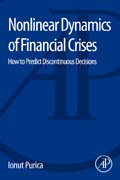
Nonlinear Dynamics of Financial Crises: How to Predict Discontinuous Decisions
Purica, Ionut
When just a handful of economists predicted the 2008 financial crisis, people should wonder how so many well educated people with enormous datasets and computing power can be so wrong. In this short book Ionut Purica joins a growing number of economists who explore the failings of mainstream economics and propose solutions developed in other disciplines, such as sociology and evolutionary biology. While it might be premature to call for a revolution, Dr. Purica echoes John Maynard Keynes in believing that economic ideas are dangerous for good or evil. In recent years evil seems to have had the upper hand. Nonlinear Dynamics of Financial Crises points to their ability to do good. Makes complex economics ideas accessible by carefully explaining technical terms and minimizing mathematics and equationsDelivers easily-understood perspectives about the global economy by constructing broad assumptions and conclusions in the face of its infinitely complexity Challenges received economic ideas by focusing on human behavior and the roles it plays in easily-observable recent trends and events INDICE: 1. Introduction 2. Evolution of Financial Crises 3. The Socio-Cultural Niche 4. Occupy the Financial Niche - Saturation and Crisis 5 Monitoring Issues and Measuring the Change 6. Non-Linear Effects in Market Penetration - Deterministic Chaos 7. Conclusions - Do We Want to Eliminate the Crises? A.1 Evolution of Models in Relation to Crisis Cycles A.2 Logistic Map
- ISBN: 978-0-12-803275-6
- Editorial: Academic Press
- Encuadernacion: Rústica
- Páginas: 150
- Fecha Publicación: 01/05/2015
- Nº Volúmenes: 1
- Idioma: Inglés
